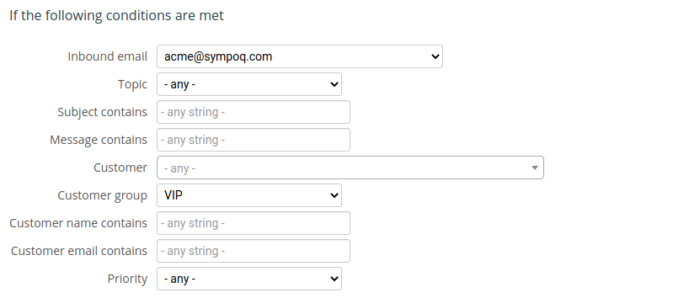Automated help desk software is one of the pillars of successful customer service and support. As their business grows, companies realize the necessity of having an automated help desk system to attend to customer queries and requests.
In a manual support process, an agent usually repeats the same task a dozen times within a working day. However, they can’t repeat the same task with 100% accuracy. Subtle variations will be inevitable in each step of the support process. Help desk automation helps businesses willingly serve customers resulting in a massive increase in their customer base and significant return on investment.
To establish a streamlined process in service and support centers, the SympoQ embedded workflow engine allows you to speed up customer requests by automatically carrying out certain predefined actions. In the long run, even the smallest enhancement can enrich customer satisfaction.
Introducing workflow rules and commands
SympoQ workflow engine allows support agents to manage processes and responsibilities, and deliver the best experience to customers. To make the best use of automation capabilities, SympoQ automatically examines all incoming support requests. Your customers may require varying intensity and levels of help depending on your product’s size and nature.
The workflow rules compare predefined actions by evaluating multiple attributes and fields with incoming support requests. The predefined actions include submissions of new requests, either by submission form, email, and customer replies. The actions from the support side, e.g. users with agent and queue manager roles, are also evaluated: agent replies, assignments, and internal log a call. Workflow rules ensure that nothing is missed out on a request by automatically carrying out commands that must follow an action:
- It helps move requests toward faster resolution
- Agents save time to focus on the core mission
- Help desk Automation facilitates support agents from performing repetitive manual tasks.

How do workflow commands work?
Workflow commands alter support tickets after an action is taken by a customer or agent based on a set of workflow rules. Each rule can be described by request attributes like the customer’s name, address, group, the topic of request raised, certain keywords included in the description, etc.
Let us look at the example of a customer support center of an IT service provider. Customers can have a single issue or a combination of various problems at various stages of their daily work. SympoQ workflow rules alter your customer support tickets whenever an action is taken.
Such examples of a support ticket raised for a customer might be, namely “System down”, “Poor performance”, and “Transaction commit declined”. These are serious concerns, and if not addressed with a prompt resolution from the support team may result in major customer dissatisfaction.
Based on these cased, SympoQ engine allows you to create separated workflow rules based on the request subject, and for each of them to describe how each of them should be handled. Going back to the example, when each of the requests is submitted, they can be assigned to the best-performing agent. As an option, they can be moved to a specific support queue, and also set with the ticket deadline.

Administrators can customize a rule and mention in the descriptions why the Workflow rule is created to act at a particular action.
Send automated e-mail notifications
Automated email notifications can also be sent to interesting parties when it comes to service requests wherein an information provision is necessary. The notifications can be sent to customers, agents who are generally assigned a particular type of request, or support managers within the team. Based on the information included, the notifications could be auto-responses, alerts, or messages with entire agent responses. You can easily change the purpose of notifications by setting up email templates.
Let’s go back to our IT service provider example once again and see how the email notification feature works. In the example, one of the requests recorded by the customer was “System down”. Generally, such cases require immediate reaction by the support team.
With Workflow rules, the IT service provider can immediately send an email notification to the customer that the issue has been recorded. Afterward, a similar email notification should be sent to the agent assigned to the issue. Eventually, the customer can also be informed that their issue has been taken into consideration and they can expect a resolution within a certain time frame.

The system keeps a record of all e-mail notifications made to customers, support agents, and managers. The internal communication within the support team is hidden from customers. Administrators can change or delete invalid rules from the system at any time.
Automation keeps happy both customers and agents
Support providers prefer SympoQ for its ease of use, multichannel support, and rule-based automation with workflow rules and commands, wherein support managers don’t lose time transferring tickets to relevant agents. They rather focus on the core problem of customers and not get deflected by the redundant tasks required by request management.
To discover the power of the workflow automation engine and other effective capabilities, sign up for a 15-day free trial of the Team subscription plan.
